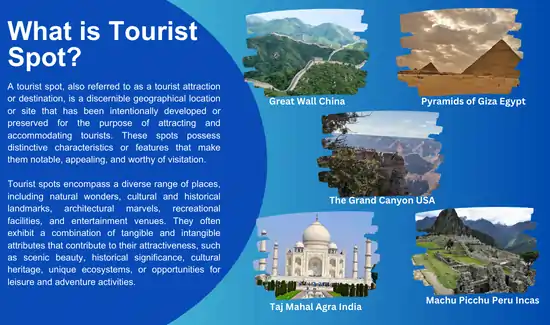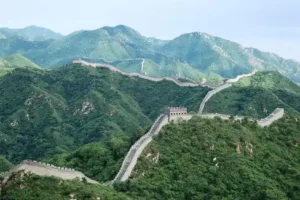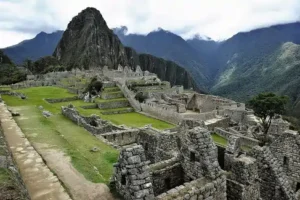
What is Tourist Spot?
Embark on a journey to discover the most captivating tourist spots across the globe. From ancient wonders like the Great Wall of China and the Pyramids of Giza to natural marvels like the Grand Canyon and cultural gems like the Taj Mahal and Machu Picchu, these destinations leave visitors spellbound. In this article, we explore these top tourist spots, showcasing their breathtaking beauty, rich history, and architectural marvels. But it doesn’t stop there—we also delve into the positive impacts these spots have on local communities, economies, and the environment. Join us as we uncover the wonders and benefits of these remarkable attractions that continue to inspire and shape the world of tourism.
Tourist Spot
A tourist spot, also referred to as a tourist attraction or destination, is a discernible geographical location or site that has been intentionally developed or preserved for the purpose of attracting and accommodating tourists. These spots possess distinctive characteristics or features that make them notable, appealing, and worthy of visitation.
Tourist spots encompass a diverse range of places, including natural wonders, cultural and historical landmarks, architectural marvels, recreational facilities, and entertainment venues. They often exhibit a combination of tangible and intangible attributes that contribute to their attractiveness, such as scenic beauty, historical significance, cultural heritage, unique ecosystems, or opportunities for leisure and adventure activities.
Read more: What is Beach Tourism?
Top Five Tourist Spots in the World
Determining the top five tourist spots in the world is subjective and can vary depending on personal preferences and criteria. However, based on their global recognition, popularity, and cultural significance, the following destinations are often considered among the top tourist spots.
- The Great Wall of China.
- The Pyramids of Giza (Egypt)
- The Grand Canyon (United States)
- The Taj Mahal (India)
- Machu Picchu,
The Great Wall of China
The Great Wall of China is an iconic tourist spot and one of the most recognizable landmarks in the world. It is a massive ancient fortification that stretches across northern China, spanning approximately 13,000 miles (21,196 kilometers) in total length. Constructed over centuries, the wall was primarily built as a defensive barrier to protect China from invasions and incursions.
The Great Wall of China offers visitors a glimpse into China’s rich history, culture, and architectural marvels. It features various sections that showcase different architectural styles, preservation efforts, and natural landscapes. Some of the popular sections include Badaling, Mutianyu, Jinshanling, and Simatai.
The Pyramids of Giza (Egypt)
The Pyramids of Giza, located on the outskirts of Cairo, Egypt, are among the most famous and awe-inspiring tourist spots in the world. These ancient structures date back to the 26th century BCE and serve as monumental tombs for the pharaohs of ancient Egypt.
The Pyramids of Giza consist of three primary pyramids: the Great Pyramid of Khufu (also known as Cheops), the Pyramid of Khafre, and the Pyramid of Menkaure. These structures were built using massive limestone blocks, meticulously crafted and stacked to create imposing geometric forms.
The Grand Canyon (United States)
The Grand Canyon, located in the southwestern United States, is a breathtaking natural wonder and a top tourist spot renowned for its immense size and stunning geological features. Carved by the Colorado River over millions of years, it stretches approximately 277 miles (446 kilometers) long, up to 18 miles (29 kilometers) wide, and reaches depths of over a mile (1.6 kilometers).
Visitors to the Grand Canyon are greeted by its awe-inspiring panoramic views, layered rock formations, and vibrant colors that result from millions of years of geological processes. The canyon exposes an extensive record of Earth’s history, with rock layers representing different eras and ecosystems.
The Taj Mahal (India)
The Taj Mahal, located in Agra, India, is an exquisite tourist spot and a UNESCO World Heritage site. Regarded as one of the most beautiful architectural masterpieces in the world, it is an enduring symbol of love, devotion, and grandeur.
Commissioned by Emperor Shah Jahan in the 17th century, the Taj Mahal was built as a mausoleum for his beloved wife, Mumtaz Mahal. The structure combines elements of Islamic, Persian, and Indian architectural styles, resulting in a harmonious and intricate design.
The Taj Mahal is renowned for its flawless white marble facade adorned with delicate inlays, intricate carvings, and intricate geometric patterns. The central dome, flanked by four minarets, stands as the focal point of the monument and represents the pinnacle of Mughal architecture.
Machu Picchu
Machu Picchu, situated in the Andes Mountains of Peru, is a captivating tourist spot and a UNESCO World Heritage site. Often referred to as the “Lost City of the Incas,” it is renowned for its breathtaking location, ancient ruins, and archaeological significance.
Machu Picchu was built by the Inca civilization around the 15th century and remained hidden from the outside world until its rediscovery in 1911. It is believed to have served as a sacred site, a royal estate, or a retreat for Inca rulers.
The beauty of Machu Picchu lies in its stunning setting amidst lush mountains and steep valleys. The site features impressive stone structures, terraces, and plazas, reflecting the exceptional architectural and engineering skills of the Incas.
Tourists visiting Machu Picchu can explore the well-preserved ruins, including the Temple of the Sun, the Intihuatana stone, and the residential areas. The Intihuatana stone, in particular, is a unique carved rock believed to have served as an astronomical and ritualistic device.
Positive Impact of Tourist Spot
Tourist spots can have several positive impacts on both the local communities and the overall economy. Here are some of the key positive impacts of tourist spots:
Economic Growth
Tourist spots can contribute significantly to the local and national economy. They generate revenue through entrance fees, accommodation, dining, transportation, and various tourist-related activities. This influx of money can boost businesses, create employment opportunities, and stimulate economic growth in the region.
Job Creation
The development of tourist spots often leads to the creation of direct and indirect jobs. Direct employment includes tour guides, hotel staff, restaurant workers, and transportation providers. Indirect employment opportunities are generated through the supply chain, such as farmers supplying produce to local restaurants or artisans selling their crafts to tourists.
Cultural Preservation
Many tourist spots are located in culturally significant areas. Tourism can encourage the preservation and revitalization of cultural heritage sites, traditions, and local arts. The need to cater to tourists often prompts communities to value and protect their cultural assets, ensuring their longevity for future generations.
Infrastructure Development
To accommodate tourists, destinations often require infrastructure development. This includes the construction or improvement of roads, airports, public transportation systems, accommodations, and recreational facilities. These developments not only benefit tourists but also enhance the overall quality of life for local residents.
Environmental Conservation
The presence of tourists can create awareness and concern for the environment. Many tourist spots are natural wonders or ecological sites, and the revenue generated from tourism can be invested in conservation efforts. This may include initiatives such as habitat restoration, wildlife protection, and sustainable tourism practices to minimize the impact on the environment.
Cultural Exchange and Understanding
Tourism promotes cultural exchange between visitors and locals. Tourists can learn about different cultures, traditions, and ways of life, fostering understanding and appreciation for diversity. Likewise, locals have the opportunity to interact with people from different backgrounds, fostering tolerance and broadening their worldview.
Community Development
Tourism can have positive social impacts on local communities. It can help revitalize rural areas, provide opportunities for entrepreneurship and small businesses, and improve the overall standard of living. The income generated from tourism can be reinvested in community projects, education, healthcare, and infrastructure, benefiting residents and creating a sense of pride in their region.
Promotion of Local Products and Services
Tourist spots often showcase local crafts, cuisine, and products. This exposure can boost the demand for locally produced goods and services, supporting local artisans, farmers, and businesses. It helps preserve traditional craftsmanship and encourages sustainable practices.
Conclusion
The world’s top tourist spots are a testament to the grandeur of human accomplishments and the beauty of nature. These destinations not only offer breathtaking experiences but also contribute positively to local communities, economies, and the environment. So, venture forth and discover the wonders of these remarkable attractions that continue to shape the world of tourism.
You may like:









